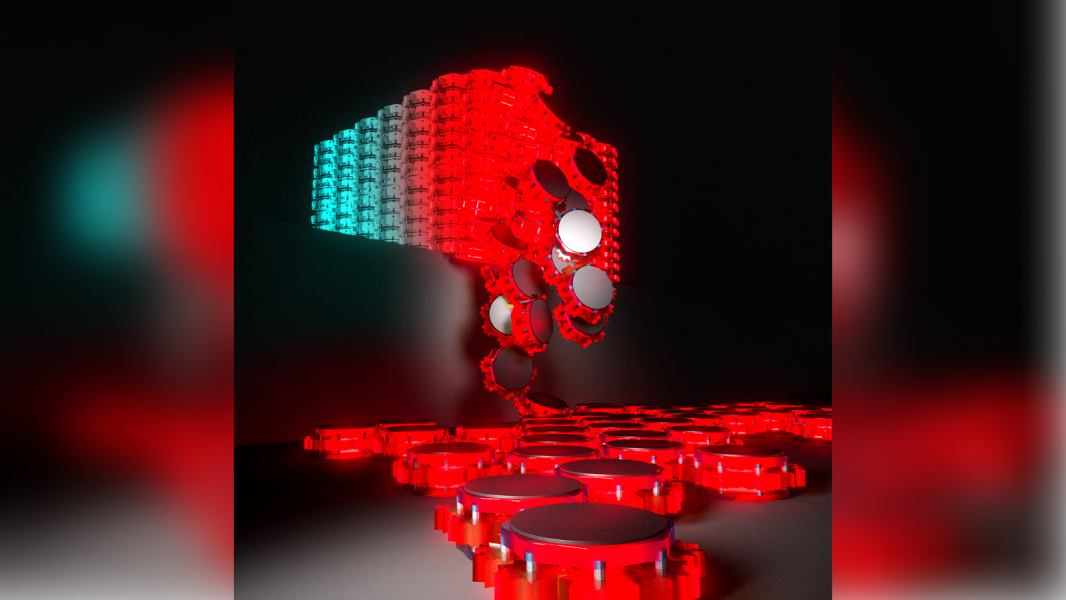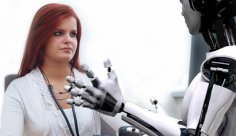
Each robot has a magnet on the bottom, yellow gears made of polylactic acid, and a center section with a ring of gears. (Photo credit: Matthew Devlin/University of California, Santa Barbara)
A new study has found that swarms of robots with collective intelligence can exhibit material-like behavior.
The robots are (mostly) cylindrical, measuring just 2.75 inches (70 millimeters) in diameter. Scientists at the University of California, Santa Barbara, and the Technical University of Dresden used 3D printing technology to create their components from polylactic acid.
Each robot has a magnet at its base, yellow polylactic acid gears, and a center with a ring of gears. Together, they can perform structural and healing tasks while supporting 700 newtons of force (500 times the robot’s weight). The scientists described the structure in a study published Feb. 20 in the journal Science.
The robots' movement is powered by magnets at their bases. These magnets allow them to “naturally cling and stay connected,” lead study author Matthew Devlin, a PhD candidate at the University of California, Santa Barbara, wrote in an email to Live Science.
“These robots are based on developing embryonic cells that connect to each other and interact to form the complex structures of life.”
The gears apply a force pattern that mimics the behavior of cells in embryonic tissue to change the overall shape and structure of the hexagonal lattice. Videos provided by the team show them in action, with the robots self-organizing into a pattern reminiscent of the cells in a honeycomb.
Eight motorized gears allow intracellular forces to become tangential forces that move each block, allowing the robots to push, pull, and move relative to each other, no matter how tight the space.
One of the team’s main research goals was to create a material that could be hard when needed, but could also adapt by adopting a softer structure. They also aimed to ensure that the robots would not only adopt a shape they could maintain, but also “selectively transition into a new shape.”
Embryonic technology
Former UC Santa Barbara professor Otger Campas previously researched how embryos physically form. Campas, who is now director of the Physics of Life Excellence Cluster at the Technical University of Dresden, helped the research team at his previous institution develop robots.
Campas' lab at the University of California, Santa Barbara, has identified a unique feature of embryos: the ability to “sculpt themselves.”
“To form, embryonic cells can cause tissues to switch between liquid and solid states, a phenomenon in physics called stiffness transitions,” Campas wrote in a paper on the research, titled “Material-like robotic assemblies with spatiotemporal control of strength and shape,” published in the journal Science.
While the team was able to reproduce the movements and state transitions of embryonic cells in their robots, Devlin told Live Science that the most exciting aspect of the experiment for him was not the change from solid to liquid, but the change in strength.
“By varying the amount of force the gears exert on each other, the robots can change their behavior to become more like a liquid or a solid,” Devlin said. He added that his favorite demonstration of this feature occurs when a researcher can stand on the robots.
After completing a proof-of-concept swarm and running a series of simulations led by research fellow Sunwoo Kim, the team was able to achieve their original goal of creating and controlling robots that behave like material objects.
The team intends to explore the possibility of scaling the system and wants to continue
Sourse: www.livescience.com





